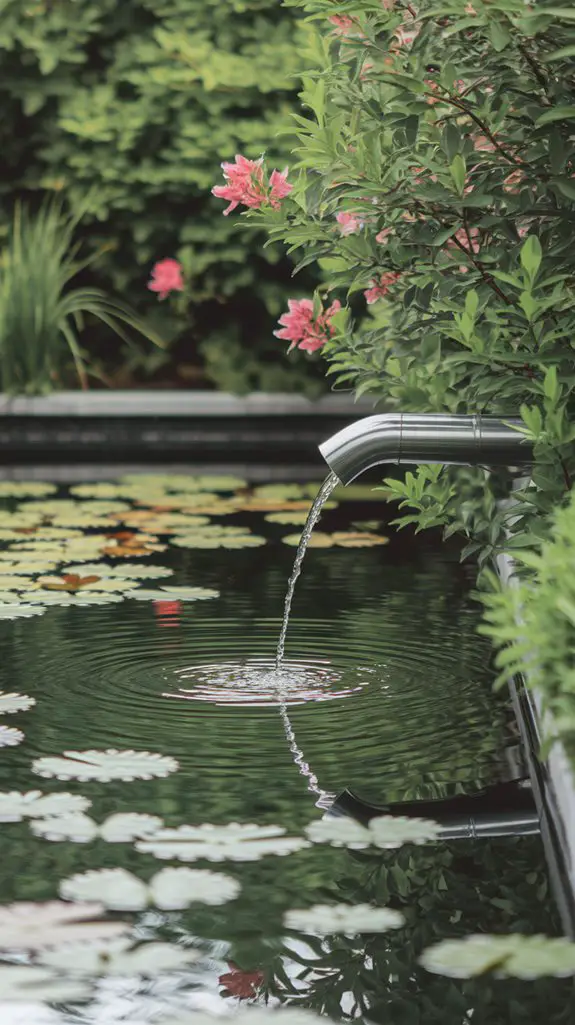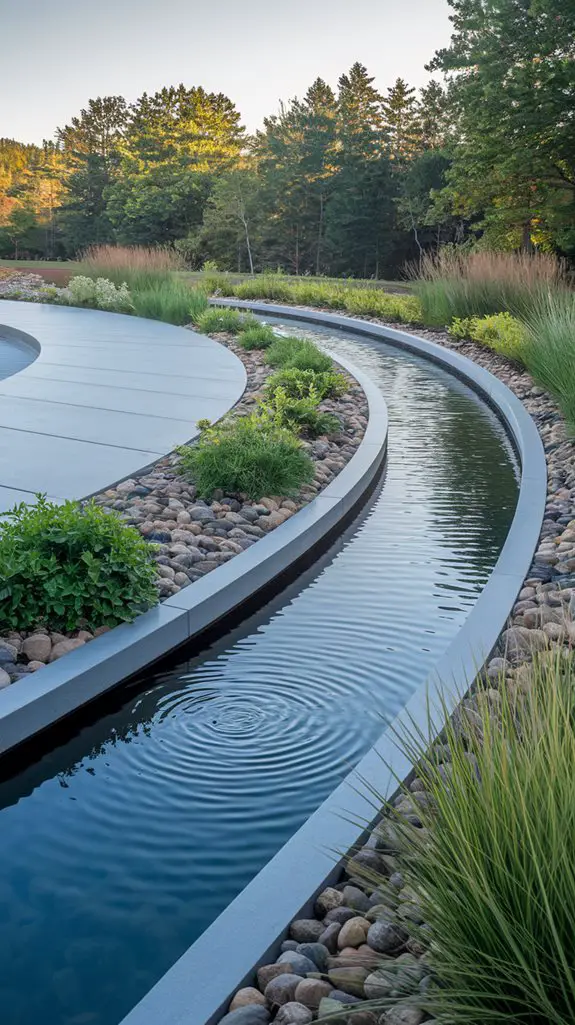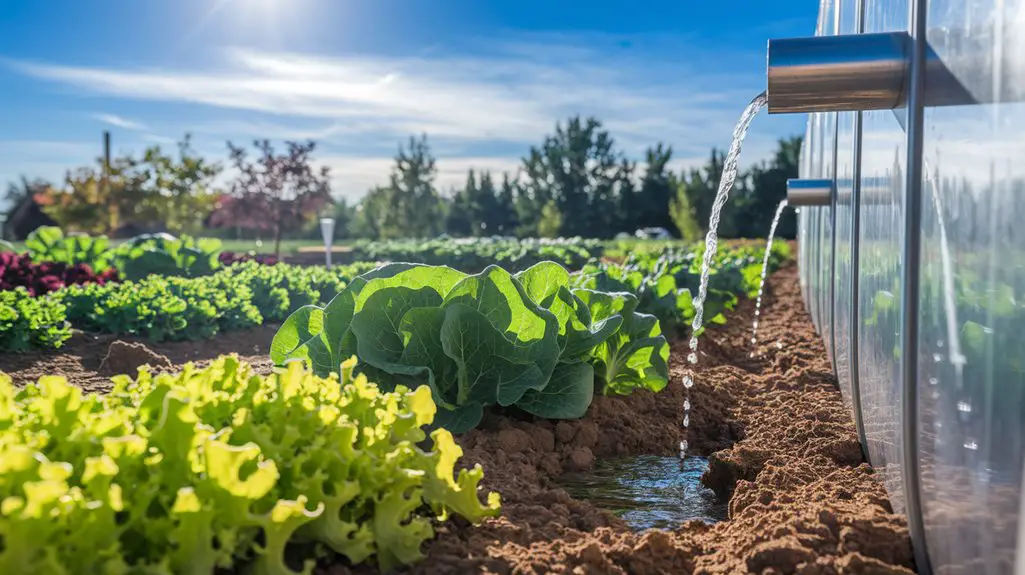While many homeowners view ponds and rainwater collection as separate systems, you’ll find a wealth of innovative solutions that unite these elements in your landscape. You don’t need to choose between sustainable water management and aesthetic appeal—the integration of these systems enhances both functionality and visual harmony. Your property’s natural water cycle can become a seamless, regenerative system that reflects ecological wisdom. Let’s explore seven approaches that transform ordinary drainage into extraordinary design.
Gravity-Fed Rain Chains and Cascading Water Features
While traditional gutters efficiently direct rainwater away from buildings, gravity-fed rain chains offer a more aesthetically pleasing and environmentally conscious alternative.
These decorative chains guide water from your roof directly to your pond system, creating soothing water music and visual interest during rainfall.
You’ll benefit from installing cascade features at strategic elevation changes between the rain chain and pond. These mini-waterfalls increase oxygen levels in the water through natural aeration while removing some pollutants through kinetic movement.
Design your cascade using natural stone or recycled materials that complement your landscape.
The entire system requires no electricity, operating purely on gravitational energy—making it both sustainable and resilient during power outages.
Position rain chains where they’ll capture maximum rainfall while remaining visible from key viewing areas. Additionally, consider implementing rainwater harvesting techniques to optimize water usage and enhance the ecological benefits of your water features.
Seamless Downspout Connections to Pond Edges

Traditional downspouts can be transformed into functional pond connections that honor both aesthetic appeal and rainwater management principles. By embedding downspout outlets directly into stone borders or naturalized edges, you’ll create a seamless connection that appears as an intentional water feature rather than an afterthought.
Install a small settling basin at the terminus to filter debris before water enters your pond. This prevents sedimentation and maintains water clarity.
For steeper grade connections, incorporate a series of small rock weirs that oxygenate incoming water while dissipating energy that could erode pond banks.
Consider using submersible exit points for properties with limited space, where downspouts can discharge below the water’s surface through properly sized piping. This approach eliminates splash erosion and creates a cleaner visual integration between your home’s architecture and aquatic ecosystem. Additionally, utilizing rainwater collection techniques can enhance your garden’s sustainability by providing a natural water source for your plants.
Bio-Filtration Swales Between Rooflines and Ponds

Bio-filtration swales serve as critical alteration zones between your roofline runoff and pond ecosystem, providing natural purification while enhancing landscape connectivity.
These shallow, vegetated channels slow water flow, allowing sediment to settle while plants and beneficial microbes process pollutants before they reach your pond.
Design your swale with a 1-2% slope and layer it with graded aggregates—larger stones at the bottom evolving to soil at the top.
Select native plants with fibrous root systems like sedges, rushes, and prairie grasses that tolerate both wet and dry conditions.
You’ll maximize filtration by creating meanders rather than straight channels. This increases water contact time with soil and roots, improving filtration efficiency.
Consider incorporating small check dams to further slow water velocity during heavy rainfall events. Additionally, implementing rainwater harvesting techniques can further enhance the overall resilience of your pond ecosystem during drought conditions.
Underground Cistern Systems With Pond Overflow Design
Underground cistern systems represent the cornerstone of advanced rainwater harvesting when integrated with pond ecosystems, creating a closed-loop water management solution for your property.
These subterranean reservoirs capture excess rainfall, storing it beneath the landscape until needed, while directing overflow into your pond during heavy precipitation events.
To design an effective cistern-pond connection:
- Install float valves that automatically divert water to ponds once cisterns reach capacity
- Incorporate pre-filtration screens to prevent debris from entering either system
- Position the cistern slightly uphill from ponds to leverage gravity-fed distribution
- Include manual bypass valves for seasonal adjustments and maintenance flexibility
You’ll find this integration particularly valuable during seasonal shifts—storing water during wet periods while maintaining pond levels during drier months, enhancing your landscape’s resilience while reducing dependence on municipal water sources. Additionally, this method aligns with innovative rainwater systems that promote sustainable practices.
Rain Gardens That Channel Water to Existing Ponds
Rain gardens serve as natural connection zones that elegantly connect your rooftop drainage systems to existing pond features, creating a functional watershed within your property boundaries. These strategically positioned depressions filter pollutants while slowing water flow, preventing erosion and pond sedimentation. Integrating rainwater systems into your landscape can enhance water conservation efforts and overall backyard design.
| Plant Type | Soil Depth | Water Filtration Capacity |
|---|---|---|
| Sedges | 12-18″ | High |
| Rushes | 18-24″ | Very High |
| Irises | 12-16″ | Medium |
| Ferns | 10-14″ | Low-Medium |
| Milkweed | 18-24″ | Medium-High |
Design your rain garden 10-30% the size of your roof’s drainage area. Position it at least 10 feet from foundations but within the natural water flow path to your pond. You’ll need a slight downward slope (1-2%) from garden to pond to guarantee proper drainage during heavy rainfall events.
Decorative Rain Barrels as Pond Fill Stations
While traditional rain barrels serve purely functional purposes, decorative versions can transform your water collection system into an aesthetic focal point that doubles as an efficient pond fill station.
You’ll find these dual-purpose elements integrate seamlessly into your landscape while supporting ecosystem health and water conservation efforts. Additionally, incorporating solar-powered features can enhance the visual appeal and sustainability of your garden.
Position barrels slightly elevated from your pond to utilize gravity flow and reduce energy consumption.
Connect a simple hose system with a valve that allows controlled water release whenever your pond needs replenishing.
- Choose ceramic barrels with hand-painted designs for formal gardens
- Select wooden rain barrels for rustic, natural settings
- Install copper or metal designs for contemporary landscapes
- Consider repurposed vessels that reflect your personal aesthetic
These systems balance technical functionality with artistry, ensuring your rainwater collection contributes to both sustainable water management and your garden’s visual harmony.
Permeable Walkways and Drainage Solutions for Pond Replenishment
As we consider sustainable water management in landscape design, permeable walkways and strategic drainage solutions emerge as elegant approaches to pond replenishment that extend beyond traditional collection methods.
You’ll find that installing pervious concrete, porous pavers, or gravel pathways allows rainwater to infiltrate directly into the soil beneath, creating natural subsurface flows toward your pond.
Position French drains or swales alongside garden paths to channel water runoff efficiently. These systems filter sediments and pollutants while directing precious rainfall to your water feature.
For maximum effectiveness, grade your landscape with a gentle slope (1-2%) toward the pond basin. This integrated approach transforms your entire property into an extensive watershed system, combining functionality with ecological design principles that conserve water and reduce erosion. Additionally, implementing rainwater collection techniques can further enhance the efficiency of your pond replenishment strategy.
Conclusion
By integrating these seven rainwater systems with your pond, you’ll create a self-sustaining ecosystem that honors the natural water cycle. Isn’t this connection between rain capture and aquatic habitat the perfect embodiment of holistic design? Your property becomes more than beautiful—it’s a functioning watershed that reduces municipal water usage, prevents runoff pollution, and creates resilience against both drought and flooding while supporting local biodiversity.



